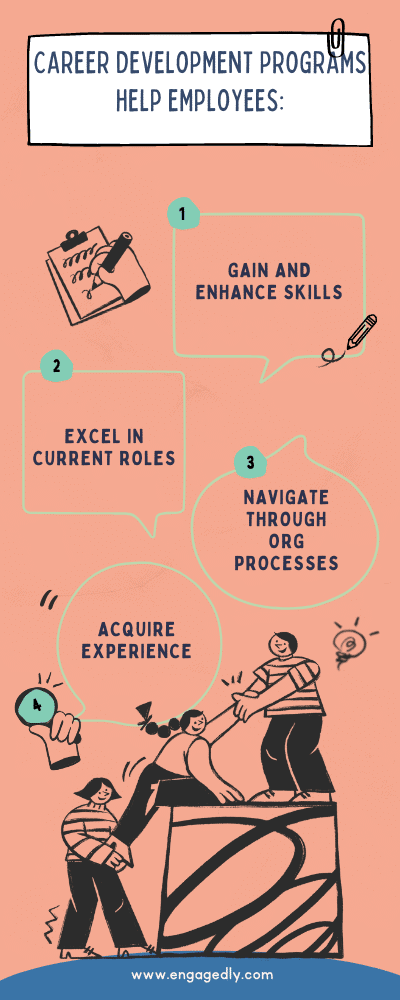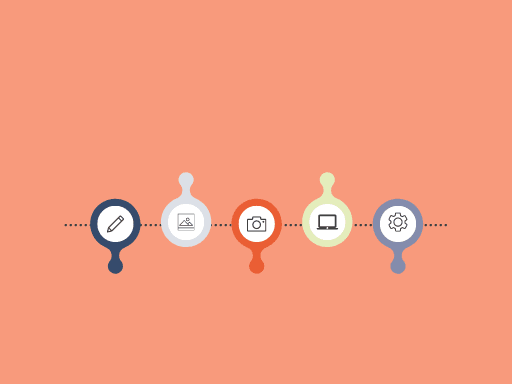Lack of career development is one of the most compelling reasons employees quit their jobs. Experts find that employees working without a clear chance of career progression are more likely to experience burnout. Once this phenomenon happens, it is common for their motivation for work and quality of service to plummet.
Employers and other company stakeholders should worry about burnout and how the lack of employee career development creates this problem. After all, losing employees too often is expensive and potentially debilitating to organizational operations. For this reason, companies should cautiously invest in competitive career development programs.
Employee Career Development Programs: An Overview
A career development program is a company-prepared plan that helps employees establish a career path and attain professional development.
The program helps employees:
-
Gain and enhance skills
-
Excel in current roles
-
Navigate through organizational systems
-
Acquire experience to qualify for career advancement opportunities
Career development programs may be specific and timebound, but they are not set in stone. As and when an employee’s career path changes, the programs should undergo necessary alterations. A well-suited program coupled with the support coming from the company would bring about significant benefits that may positively impact all involved stakeholders.
Also Read: Importance, Implementation, and Benefits of Training and Development Program
10 Major Benefits of Implementing Employee Career Development Programs
The benefits of employee career development programs are not entirely exclusive to employees. Depending on the success and consistency of the programs, other stakeholders, such as the employer, may also experience improvements in various aspects. Here is a more comprehensive look at the different advantages of having an employee career development program:
1. Reduce attrition
Employees who do not see and experience career advancement in their current position are more likely to quit. When many employees think this way, the company will be in trouble because all dissatisfied individuals may resign simultaneously. This outcome is never ideal.
Companies must keep their employees satisfied with their jobs to prevent them from resigning. Besides compensation and benefits, a good career development program could be a valuable bargaining chip. It would be irrational for employees to work for many years in a company that does not promise any promotion.
Also Read: Why Your Business Needs This Foolproof “Talent Retention Strategy”
2. Encourage employees to work harder
It is not enough for employees to show up for work and do the minimum. If this habit continues, employees will become too complacent and deliver low-quality services and some may show signs of quitting. Ideally, employees should have the willingness to strive harder and perform better.
Implementing a career development program can help challenge employees to bring out their A game. Since they know they have goals to meet, they would consciously work hard to attain the said goals. A little work pressure will push them to move forward.
3. Inspire professional development among employees
There are multiple directions that employees can steer their careers toward. Most of the time, employees move their careers vertically or horizontally. Vertical career growth is about promotions and occupying a higher position, while horizontal career growth refers to a transfer to another industry or functional role.
Whether moving vertically or horizontally, having chances for professional development can strengthen employees’ love and respect for their jobs. They may reignite their passion for their careers and strive to be better.
4. Challenge employees to take on a new career path
One may need to explore multiple options before settling into a chosen career. Even after establishing oneself in a selected position, it is still possible to change into something else.
Many employees are not satisfied with their current career paths. Thus, employers should provide opportunities for employees to explore other paths which could later contribute to their overall growth. Once they know what is out there, they feel more motivated to strive harder.
5. Survive unexpected crises
Before leading to better career opportunities, career development programs equip employees with skills that may or may not relate to their current jobs. These skills give them better competencies in varied professional aspects. Most importantly, these skills will prepare them for challenging circumstances.
As employees grow, they develop faster and better reactions against crises. More talented and experienced workers will help companies keep up with drastic changes. Their contributions will be crucial for the company’s survival.
6. Improve overall organizational performance
Besides technical skills, career development programs also focus on soft skills. Teamwork is one of the most relevant soft skills to learn across all industries. As employees grow, they also learn how to cooperate with others and carry out common goals.
Organization at the workplace promotes orderliness and efficiency. For co-workers, being able to work well with others could signify the existence of a peaceful and functional work culture. Workers should get along with one another.
Also Read: Create a Positive Workplace Culture For Your Employees
7. Reduce work-related errors
As employees do better in their respective positions, they are less likely to commit errors.
These errors cover technical difficulties that one might experience while working on projects and interpersonal issues that may cause toxicity in the workplace.
Climbing the corporate ladder can be daunting, so people need consistent and reliable support. Ideally, employees should have access to career development opportunities in managing pressure, stress, and other negative factors to prevent them from continuously committing mistakes.
8. Attract the best talent
Creating employee career growth plans and other similar programs can also be relevant to recruitment processes. After the company establishes a culture and system for its employees’ career advancement, the public will know, and applicants will become interested.
Talented and high-performing individuals can be picky with their employers, so attracting them with beneficial proposals is crucial. When these exemplary employees excel, naturally, the companies employing them will also experience a boost in productivity and performance.
9. Prepare for succession planning
Succession planning is a preemptive strategy that prevents the interruption of business and operations. It is about preparing employees to take on a higher and more challenging position in case the previous person on the job voluntarily or involuntarily quits.
This initiative helps companies forecast who could be the company’s next leaders. It is a preemptive measure that helps ensure organizational stability. For employees, having concrete succession planning is good motivation to work even harder.
10. Instill a progressive work culture
Implementing employee career growth plans may improve a company’s work culture. Aside from the encouragement employees get after knowing that something good can be attainable for performing well, they may also develop a sense of accountability to keep up with their responsibilities. While it takes time, this perspective can spread to all employees and make them more goal-oriented and competitive.
End Note: Maximize Career Development Opportunities
Nowadays, there are endless ways for companies to foster employee career development. Besides onsite training and conventions, employers may also utilize career development e-learning courses for faster and more dynamic career progression. Regardless of how employers handle this situation, they should provide diverse improvement programs to accommodate employees’ varying needs and goals.
Frequently Asked Questions
Q1. What are the main benefits of career planning to an organization?
Ans. There are quite a few benefits in store for organizations who invest in an employee’s career planning, such as:
- Attracting and retaining good talent
- Promoting the brand image
- Utilizing resources to their fullest potential
- Preventing chaos and disruption in processes
Q2. What are the benefits of employee development and training?
Ans. Employee training is primarily about learning new skills and gaining specific knowledge that employees can apply immediately to make major gains in their current job positions, whereas development programs promote employees’ future performance and progress.
Subscribe To The Engagedly Newsletter









